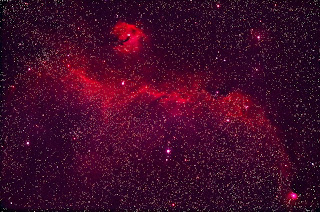The image below shows the waxing gibbous moon in between three bright stars. The two north of the moon (near the top) are Pollux and Caster and belong to Gemini while the star south of the moon (near the bottom) is Procyon, the brightest star in Canis Minor. I was looking for something to image and saw a post in Earthsky of something neat to look at and decided this was it. The image is a composite of a short 1/1800 second image to get the lunar detail and a long 30 second exposure to get the star field.
Image 1
Waxing Gibbous MoonLocation: Home Monroe, CT
Date: 3-25-18
Camera: Canon EOS Rebel T3i(a), Backyard EOS
Lens: Canon 18-55 mm
Barlow: None
Focal Length: 35mm
f/7.1
Focal Reducer: None
Mount: Orion Sirius EQ
Filter: Astrodon UV/IR
Autoguiding: none
Exposure: 1 x 1/1800s, 1 x 30
ISO: 400, 800
Temp: -3 C
Post Processing: Photoshop, Astronomy Tools
https://kurtzeppetello.smugmug.com/
Image 2
This is the second image I took on March 25. It still shows Pollux, Caster, and Procyon but clouds partially blocked it and produced the halo. I rotated the image to better frame it.
Waxing Gibbous Moon
Location: Home Monroe, CT
Date: 3-25-18
Camera: Canon EOS Rebel T3i(a), Backyard EOS
Lens: Canon 18-55 mm
Barlow: None
Focal Length: 35mm
f/7.1
Focal Reducer: None
Mount: Orion Sirius EQ
Filter: Astrodon UV/IR
Autoguiding: none
Exposure: 1 x 1/15s
ISO: 1600
Temp: -3 C
Post Processing: Photoshop, Astronomy Tools
Image 2
This is the second image I took on March 25. It still shows Pollux, Caster, and Procyon but clouds partially blocked it and produced the halo. I rotated the image to better frame it.
Location: Home Monroe, CT
Date: 3-25-18
Camera: Canon EOS Rebel T3i(a), Backyard EOS
Lens: Canon 18-55 mm
Barlow: None
Focal Length: 35mm
f/7.1
Focal Reducer: None
Mount: Orion Sirius EQ
Filter: Astrodon UV/IR
Autoguiding: none
Exposure: 1 x 1/15s
ISO: 1600
Temp: -3 C
Post Processing: Photoshop, Astronomy Tools
https://kurtzeppetello.smugmug.com/
Image 3
This is the third and last image I took on March 25 and is only picture I took through the ED80. The terminus shows up pretty well and many craters such as Plato near the top just above Mare Imbrium and Tycho on the bottom.
Waxing Gibbous Moon
Location: Home Monroe, CT
Date: 3-25-18
Camera: Canon EOS Rebel T3i(a), Backyard EOS
Telescope: Orion ED80 80mm f/7.5 Apochromatic Refractor Telescope
Barlow: None
Focal Length: 600mm
f/7.5
Focal Reducer: Orion 0.8x Focal Reducer for Refractor Telescopes
Mount: Orion Sirius EQ
Filter: Astrodon UV/IR
Autoguiding: none
Exposure: 1 x 1/1000s
ISO: 400
Temp: -3 C
Post Processing: Photoshop, Astronomy Tools
Image 3
This is the third and last image I took on March 25 and is only picture I took through the ED80. The terminus shows up pretty well and many craters such as Plato near the top just above Mare Imbrium and Tycho on the bottom.
Location: Home Monroe, CT
Date: 3-25-18
Camera: Canon EOS Rebel T3i(a), Backyard EOS
Telescope: Orion ED80 80mm f/7.5 Apochromatic Refractor Telescope
Barlow: None
Focal Length: 600mm
f/7.5
Focal Reducer: Orion 0.8x Focal Reducer for Refractor Telescopes
Mount: Orion Sirius EQ
Filter: Astrodon UV/IR
Autoguiding: none
Exposure: 1 x 1/1000s
ISO: 400
Temp: -3 C
Post Processing: Photoshop, Astronomy Tools












